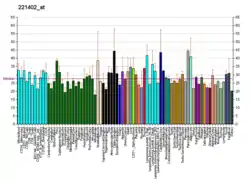| OR1F1 | |||||||||||||||||||||||||||||||||||||||||||||||||||
|---|---|---|---|---|---|---|---|---|---|---|---|---|---|---|---|---|---|---|---|---|---|---|---|---|---|---|---|---|---|---|---|---|---|---|---|---|---|---|---|---|---|---|---|---|---|---|---|---|---|---|---|
| Identifiers | |||||||||||||||||||||||||||||||||||||||||||||||||||
| Aliases | OR1F1, OLFMF, OR16-36, OR16-37, OR16-88, OR16-89, OR16-90, OR1F10, OR1F13P, OR1F4, OR1F5, OR1F6, OR1F7, OR1F8, OR1F9, OR3-145, ORL1023, olfactory receptor family 1 subfamily F member 1 | ||||||||||||||||||||||||||||||||||||||||||||||||||
| External IDs | OMIM: 603232 HomoloGene: 110537 GeneCards: OR1F1 | ||||||||||||||||||||||||||||||||||||||||||||||||||
| |||||||||||||||||||||||||||||||||||||||||||||||||||
| |||||||||||||||||||||||||||||||||||||||||||||||||||
| |||||||||||||||||||||||||||||||||||||||||||||||||||
| Wikidata | |||||||||||||||||||||||||||||||||||||||||||||||||||
| |||||||||||||||||||||||||||||||||||||||||||||||||||
Olfactory receptor 1F1 is a protein that in humans is encoded by the OR1F1 gene.[2][3][4]
Olfactory receptors interact with odorant molecules in the nose, to initiate a neuronal response that triggers the perception of a smell. The olfactory receptor proteins are members of a large family of G-protein-coupled receptors (GPCR) arising from single coding-exon genes. Olfactory receptors share a 7-transmembrane domain structure with many neurotransmitter and hormone receptors and are responsible for the recognition and G protein-mediated transduction of odorant signals. The olfactory receptor gene family is the largest in the genome. The nomenclature assigned to the olfactory receptor genes and proteins for this organism is independent of other organisms.[4]
See also
References
- ↑ "Human PubMed Reference:". National Center for Biotechnology Information, U.S. National Library of Medicine.
- ↑ French Fmf, Consortium (Oct 1997). "A candidate gene for familial Mediterranean fever". Nat Genet. 17 (1): 25–31. doi:10.1038/ng0997-25. PMID 9288094. S2CID 24259548.
- ↑ Rouquier S, Taviaux S, Trask BJ, Brand-Arpon V, van den Engh G, Demaille J, Giorgi D (Mar 1998). "Distribution of olfactory receptor genes in the human genome". Nat Genet. 18 (3): 243–50. doi:10.1038/ng0398-243. PMID 9500546. S2CID 31129045.
- 1 2 "Entrez Gene: OR1F1 olfactory receptor, family 1, subfamily F, member 1".
Further reading
- Bernot A, Heilig R, Clepet C, et al. (1998). "A transcriptional Map of the FMF region". Genomics. 50 (2): 147–60. doi:10.1006/geno.1998.5313. PMID 9653642.
- Fuchs T, Malecova B, Linhart C, et al. (2003). "DEFOG: a practical scheme for deciphering families of genes". Genomics. 80 (3): 295–302. CiteSeerX 10.1.1.135.3652. doi:10.1006/geno.2002.6830. PMID 12213199.
- Strausberg RL, Feingold EA, Grouse LH, et al. (2003). "Generation and initial analysis of more than 15,000 full-length human and mouse cDNA sequences". Proc. Natl. Acad. Sci. U.S.A. 99 (26): 16899–903. Bibcode:2002PNAS...9916899M. doi:10.1073/pnas.242603899. PMC 139241. PMID 12477932.
- Malnic B, Godfrey PA, Buck LB (2004). "The human olfactory receptor gene family". Proc. Natl. Acad. Sci. U.S.A. 101 (8): 2584–9. Bibcode:2004PNAS..101.2584M. doi:10.1073/pnas.0307882100. PMC 356993. PMID 14983052.
- Gerhard DS, Wagner L, Feingold EA, et al. (2004). "The Status, Quality, and Expansion of the NIH Full-Length cDNA Project: The Mammalian Gene Collection (MGC)". Genome Res. 14 (10B): 2121–7. doi:10.1101/gr.2596504. PMC 528928. PMID 15489334.
External links
- OR1F1+protein,+human at the U.S. National Library of Medicine Medical Subject Headings (MeSH)
This article incorporates text from the United States National Library of Medicine, which is in the public domain.
